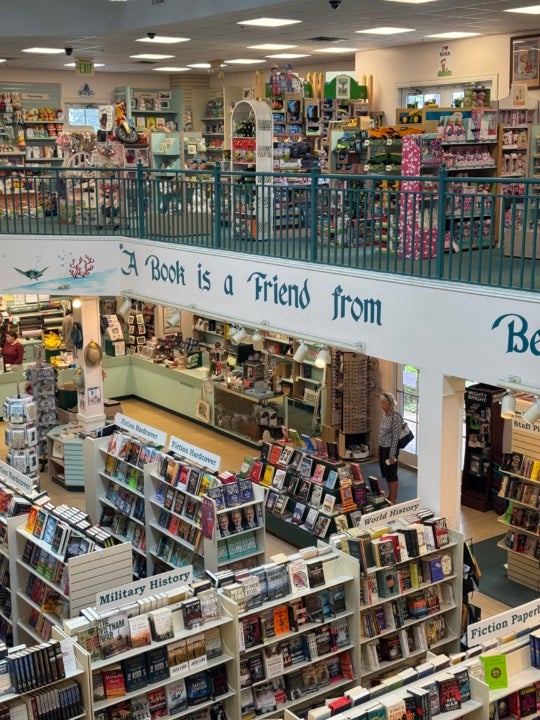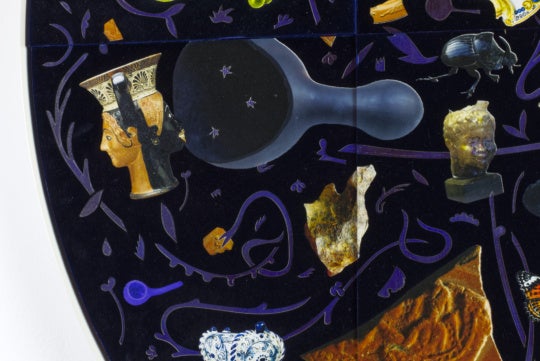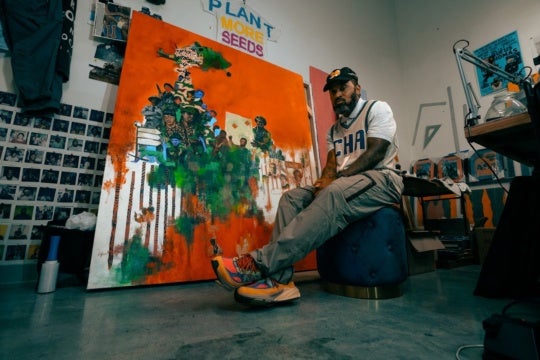
Benjamin Britton employs paint, spatial illusion and ideas of perception in a brilliant collection of paintings designed to reward the sensory experiences of looking. The arresting results remind us of the essential power of painting, why painting matters and why it prevails as a necessary form of communication distinct from writing or the spoken word.
“The Incandescent Sub-Present,” Britton’s second solo exhibition at Marcia Wood Gallery through December 23, comprises 12 medium-sized to large paintings in oil and acrylic on canvas made in the past three years. The collection that at first glance lends a bright, kaleidoscopic feel to the space yields, with time and closer inspection, a deeply rewarding sensory experience — and for good reason, the artist intends it this way.
Simply put, Britton’s subject is three-fold: the pleasures in the sensory experience of looking, the many formations of the present moment (including the sub-present, the titular phrase Britton employs to describe “the glowing totality of all the woven sensation within the present moment”), and our relationship to nature and the ecological world. Central to the experience is Britton’s generosity as an artist. His prismatic planes and intersecting space are designed to allow his viewers to project themselves into his illusionistic space, for, to Britton, any meaning inherent in painting, or at least painting after Frank Stella, derives from the viewer’s experience of it. Paintings as generous in content as these remind that physical representation is often the best, and sometimes only, way to convey the subjective.

Sublime moments in nature are a repeating subject in Britton’s work. The very nature of the sublime is that a little terror lurks behind all the beauty. Chaos rests just beneath the surface, along with an ever present potential for threat or the idea that change might be afoot. In several, a miniature scene located centrally in the painting draws the viewer into the picture, offering the possibility of narrative resolution amid the shards of shape and plane. Alternately, those shards seem to fly out from the calm center of that very same image, evoking the idea of chaos in a way reminiscent of a line from “The Second Coming” by William Butler Yeats: “Things fall apart; the centre cannot hold.” In Body first, but not always, then mind, also not always (2016), a tiny quiet scene suggesting festival-goers at twilight is refracted into images of shadows, pools of reflected light, colored flags moving in an unseen breeze made present by the sense of movement in the picture plane. Everywhere and everything, all at once.
In another, Attended-to from the most casual organs (2016), scenes suggesting a day at the beach—sand, pure blue sky, a torso, even skin, that most tactile and encompassing of organs—deliver the sensations of a summer day. The breeze announces itself here too in floating scarves in colorful fabrics, planes evoking a beach umbrella and its attendant shade surround a tiny pastoral scene of vultures devouring the carcass of an unidentifiable beached creature at water’s edge.

Britton writes in his statement that he plays “a kind of brinkmanship with chaos within the conventions of pictorial art.” Nowhere is chaos more manifest than in Mated along a broad meridian (2015), but even here it is chaos that blinks; Britton is always in control. A gyre-like sense of barely controlled movement is portrayed in shapes suggestive of a mirror ball or flickering lights. Doomsday digital numbers and letters “scroll” across the plane adding to a sense of confusion and information overload. A large oval on a bed of night sky or dark water dominates the canvas, while five tiny white filaments suggesting lightning or bleached tree trunks draw a distant horizon.

The horizon line is a recurring and grounding element, even when, as it often does, it feels like a memory, or what Britton calls “the residue of experience.” In Forgetting-by-remembering (2015), distant green lights (albeit two) elicit comparison to Gatsby’s cross-Manhasset Bay infatuation with Daisy’s dock, but Britton revealed at his talk on December 17 that they derive from memories of a dusky moment spent on the St. John’s River in Florida with gentle manatees. Here he captured his own memory of the glow of headlamps and red flashlights. Lines inspired by the warp and weft of weaving appear in many of the paintings and inject the idea of connection, seen and unseen, and of a shuttling between moments, the ever-present sub-present of movement beneath and within the present moment – the ways in which we use cognition of the past and the future to move through the present.

Britton employs color, shape, line, edge, space and image in service of paintings that, as he put it in his talk in the gallery on Saturday, make “you feel that you have superpowers when you are looking at them,” and there is an attendant sense of seeing into the unseen, of piercing the facade of our own limited perception. Britton aspires to match the conditions of painting—color, edge, scale, velocity—with the conditions of the sensory environment in the painting—barometric pressure, temperature, wind speed, moisture—be it twilight on a Florida river or the beach on a breezy day, lending an atmospheric quality to much of the work in which one senses before knowing—or rather comes to know through the senses.
With Britton’s paintings, the allusion to mirrored shards is unavoidable. As with a shattered mirror, an image, formerly whole, is fragmented into parts. Each shard, by offering a different viewpoint and way of seeing, tells a different story. Rather, with time spent, a sense of possibility emanates from paintings that seemed initially to exist on the verge of chaos. Seeing the many planes and not just the one offers a deepening sense of the sub-present, Britton’s “totality of all woven sensation.” Viewed this way, the near-chaos of splintered image gives way to a previously unseen whole. In today’s fractious climate, the ability to attend to differing viewpoints in a way that constructs the whole is more valuable now than ever.
Donna Mintz is an Atlanta-based visual artist who also writes about art. She is an MFA candidate the Sewanee School of Letters and a fellow of the Hambidge Center of Arts and Sciences. Mintz is represented by Sandler Hudson Gallery.




